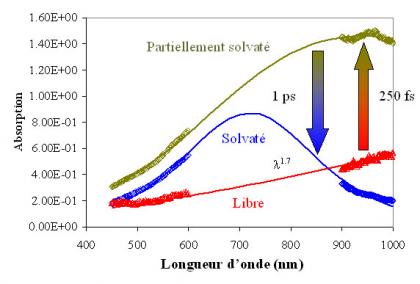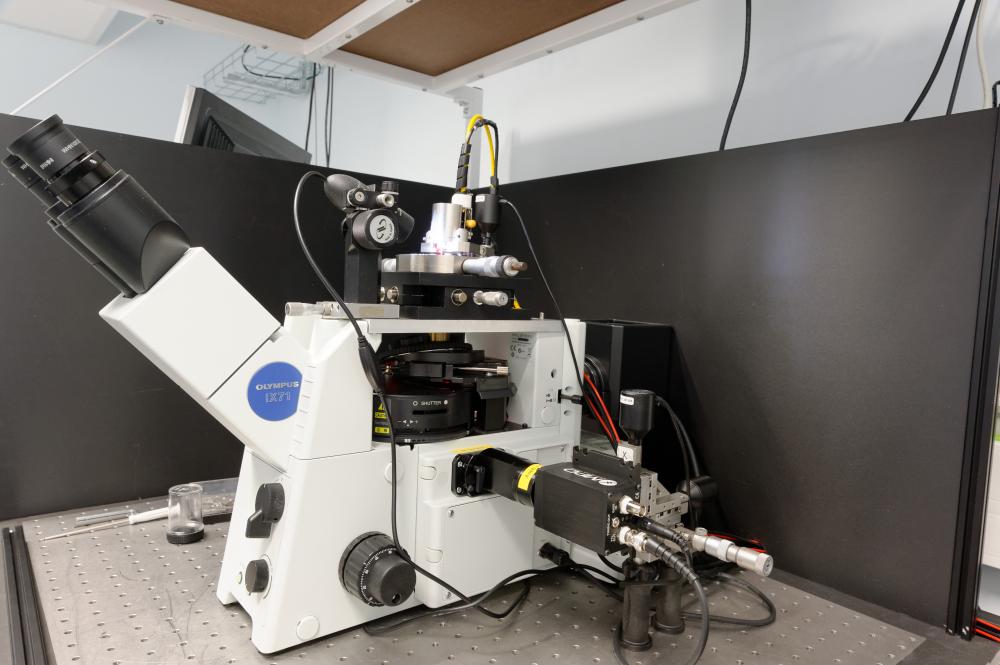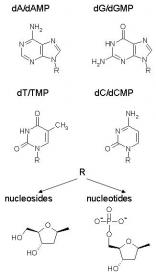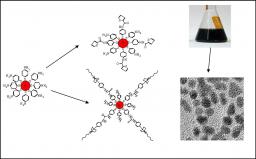Pages scientifiques 2009
Un des problèmes fondamentaux en chimie sous rayonnement est la compréhension de la réactivité de l'électron. En effet, l'interaction entre un rayonnement ionisant et la matière produit des traces où la concentration en électron hydraté, en radical hydroxyl, et en ion hydronium peut atteindre la centimole, voire la mole par litre. Bien que de très nombreuses études expérimentales et théoriques aient porté sur la solvatation et la réactivité de l'électron en faible concentration, il n'existe aucune information expérimentale sur sa réactivité à très forte concentration. Cette constatation nous a incité à développer un nouvel axe de recherche dont l'objectif est d'appliquer les méthodes expérimentales de la femtochimie à la chimie sous rayonnement.
Malgré la résistance des bases de l’ADN isolées en solution vis-à-vis du rayonnement UV, ce dernier peut néanmoins déclencher des réactions photochimiques conduisant à des mutations cancérigènes lorsqu’il est absorbé par la double hélice. Si les produits de ces réactions sont bien caractérisés, les processus fondamentaux qui précèdent leur formation ne sont pas encore compris. Nous travaux récents montent que :
- un photon UV n’est pas absorbé individuellement par une seule base mais collectivement par un ensemble de bases (excitons)
- un transfert d’énergie entre états excitoniques a lieu à des temps inférieurs à 100 fs
- l’organisation de bases au sein des hélices peut conduire à un abaissement de leur potentiel d’ionisation
- la formation des photo-adduits (6-4) dans une simple hélice (dT)20 a lieu en 4 ms et implique un intermédiaire de réaction.
Ultrafast Excited-State Deactivation of 8-Hydroxy-2′-Deoxyguanosine Studied by Femtosecond Fluorescence Spectroscopy and Quantum-Chemical Calculations
P. Changenet-Barret, T. Gustavsson, R. Improta, D. Markovitsi
J. Phys. Chem. A 2015, 119, 6131–6139.
A joint experimental/theoretical study of the ultrafast excited state deactivation of deoxyadenosine and 9-methyladenine in water and acetonitrile
T. Gustavsson, N. Sarkar, I. Vayá, M.C. Jiménez, D. Markovitsi, R. Improta
Photochem. Photobiol. Sci. 2013, 12, 1375 - 1386.
The effect of methylation on the excited state dynamics of aminouracils
T. Gustavsson, R. Improta, Á. Bányász, I. Vaya, D. Markovitsi
J. Photochem. Photobiol. A 2012, 234, 37-43.
Femtosecond fluorescence studies of DNA/RNA constituents
T. Gustavsson, A. Banyasz, R. Improta, D. Markovitsi
J. Phys. : Conference Series 2011, 261, 012009.
Excited-State Dynamics of dGMP Measured by Steady-State and Femtosecond Fluorescence Spectroscopy
F. A. Miannay, T. Gustavsson, A. Banyasz, D. Markovitsi
J. Phys. Chem. A 2010, 114, 3256-3263.
DNA/RNA Building Blocks of Life Under UV Irradiation
T. Gustavsson, R. Improta, D. Markovitsi
J. Phys. Chem. Letts. 2010, 1, 2025-2030.
The Peculiar Spectral Properties of Amino-Substituted Uracils: A Combined Theoretical and Experimental Study
A. Banyasz, S. Karpati, Y. Mercier, M. Reguero, T. Gustavsson, D. Markovitsi, R. Improta
J. Phys. Chem. B 2010, 114, 12708–12719
Assessing solvent effects on the singlet excited state dynamics of uracil derivatives:
A femtosecond fluorescence upconversion study in alcohols and D2O
T. Gustavsson, A. Banyasz, N. Sarkar, D. Markovitsi, R. Improta
Chem. Phys. 2008, 350, 186-192.
Effect of amino substitution on the excited state dynamics of uracil
Á. Bányász, T. Gustavsson, E. Keszei, R. Improta, D. Markovitsi
Photochem. Photobiol. Sci. 2008, 7, 765-768.
Solvent effects on the steady-state absorption and emission spectra of the three pyrimidine bases uracil, thymine and 5-fluorouracil
T. Gustavsson, N. Sarkar, Á. Bányász, D. Markovitsi, R. Improta
Photochem. Photobiol. 2007, 83, 595-599.
Solvent effect on the singlet excited state lifetimes of nucleic acid bases: a computational study of 5-fluorouracil and uracil in acetonitrile and water
F. Santoro, V. Barone, T. Gustavsson, R. Improta
J. Am. Chem. Soc. 2006, 128, 16312-16322.
Singlet excited state dynamics of uracil and thymine derivatives. A femtosecond fluorescence upconversion study in acetonitrile
T. Gustavsson, N. Sarkar, E. Lazzarotto, D. Markovitsi, R. Improta
Chem. Phys. Lett. 2006, 429, 551-557.
Solvent effect on the singlet excited state dynamics of 5-fluorouracil in acetonitrile as compared to water
T. Gustavsson, N. Sarkar, E. Lazzarotto, D. Markovitsi, V. Barone, R. Improta
J. Phys. Chem. B 2006, 110, 12843 - 12847.
Singlet excited state behavior of uracil and thymine in aqueous solution: a combined experimental and computational study of 11 uracil derivatives
T. Gustavsson, A. Banyasz, E. Lazzarotto, D. Markovitsi, G. Scalmani, M. J. Frisch, V. Barone, R. Improta
J. Am. Chem. Soc. 2006, 128, 607-619.
Cytosine excited state dynamics studied by femtosecond absorption and fluorescence spectroscopy
A. Sharonov, T. Gustavsson, V. Carré, E. Renault, D. Markovitsi
Chem. Phys. Lett., 2003, 380, 173.
Photophysical properties of 5-methylcytosine
A. Sharonov, T. Gustavsson, S. Marguet , D. Markovitsi
Photochem. Photobiol. Sci. 2003, 2, 1.
Fluorescence properties of DNA nucleosides and nucleotides: a refined steady-state and femtosecond investigation
D. Onidas, D. Markovitsi, S. Marguet, A. Sharonov, T . Gustavsson
J. Phys. Chem. B, 2002, 106, 11367.
Thymine, thymidine and thymidine 5'-monophosphate studied by femtosecond fluorescence upconversion spectroscopy
T . Gustavsson, A. Sharonov, D. Markovitsi
Chem. Phys. Lett. 2002, 351, 195.
Adenine, deoxyadenosine and deoxyadenosine 5'-monophosphate studied by femtosecond fluorescence upconversion spectroscopy
T . Gustavsson, A. Sharonov, D. Onidas, D. Markovitsi
Chem. Phys. Lett. 2002, 356, 49.
The Peculiar Spectral Properties of Amino-Substituted Uracils: A Combined Theoretical and Experimental Study A. Banyasz, S. Karpati, Y. Mercier, M. Reguero, T. Gustavsson, D. Markovitsi, R. Improta, J. Phys. Chem. B 2010, 114, 12708–12719
Assessing solvent effects on the singlet excited state dynamics of uracil derivatives: A femtosecond fluorescence upconversion study in alcohols and D2O T. Gustavsson, A. Banyasz, N. Sarkar, D. Markovitsi, R. Improta, Chem. Phys.2008, 350, 186-192.
Effect of amino substitution on the excited state dynamics of uracil Á. Bányász, T. Gustavsson, E. Keszei, R. Improta, D. Markovitsi, Photochem. Photobiol. Sci. 2008, 7, 765-768.
Solvent effects on the steady-state absorption and emission spectra of the three pyrimidine bases uracil, thymine and 5-fluorouracil T. Gustavsson, N. Sarkar, Á. Bányász, D. Markovitsi, R. Improta, Photochem. Photobiol. 2007, 83, 595-599.
Solvent effect on the singlet excited state lifetimes of nucleic acid bases: a computational study of 5-fluorouracil and uracil in acetonitrile and water F. Santoro, V. Barone, T. Gustavsson, R. Improta, J. Am. Chem. Soc. 2006, 128, 16312-16322.
Singlet excited state dynamics of uracil and thymine derivatives. A femtosecond fluorescence upconversion study in acetonitrile T. Gustavsson, N. Sarkar, E. Lazzarotto, D. Markovitsi, R. Improta, Chem. Phys. Lett. 2006, 429, 551-557.
Solvent effect on the singlet excited state dynamics of 5-fluorouracil in acetonitrile as compared to water T. Gustavsson, N. Sarkar, E. Lazzarotto, D. Markovitsi, V. Barone, R. Improta, J. Phys. Chem. B 2006, 110, 12843 - 12847.
Singlet excited state behavior of uracil and thymine in aqueous solution: a combined experimental and computational study of 11 uracil derivatives T. Gustavsson, A. Banyasz, E. Lazzarotto, D. Markovitsi, G. Scalmani, M. J. Frisch, V. Barone, R. Improta, J. Am. Chem. Soc. 2006, 128, 607-619.
Cytosine excited state dynamics studied by femtosecond absorption and fluorescence spectroscopy A. Sharonov, T. Gustavsson, V. Carré, E. Renault, D. Markovitsi, Chem. Phys. Lett., 2003, 380, 173.
Photophysical properties of 5-methylcytosine A. Sharonov, T. Gustavsson, S. Marguet , D. Markovitsi, Photochem. Photobiol. Sci. 2003, 2, 1.
Fluorescence properties of DNA nucleosides and nucleotides: a refined steady-state and femtosecond investigation D. Onidas, D. Markovitsi, S. Marguet, A. Sharonov, T . Gustavsson, J. Phys. Chem. B, 2002, 106, 11367.
Thymine, thymidine and thymidine 5'-monophosphate studied by femtosecond fluorescence upconversion spectroscopy T . Gustavsson, A. Sharonov, D. Markovitsi, Chem. Phys. Lett. 2002, 351, 195.
Adenine, deoxyadenosine and deoxyadenosine 5'-monophosphate studied by femtosecond fluorescence upconversion spectroscopy
T . Gustavsson, A. Sharonov, D. Onidas, D. Markovitsi, Chem. Phys. Lett. 2002, 356, 49.
Le LEPO effectue des recherches dans le domaine de l’interaction lumière-matière à l’échelle nanométrique, notamment dans des assemblées de nanoparticules et des systèmes moléculaires ou hybrides organisés.
Le groupe a développé un savoir-faire important d’une part dans la microscopie de photoémission d’électrons et d’autre part dans le couplage de mesures de micro-spectroscopie optique (absorption, fluorescence, diffusion Raman, conversion de fréquence) avec des microscopies à sondes locales (AFM, STM). Une sélection de ces réalisations expérimentales est présentée ci-dessous.
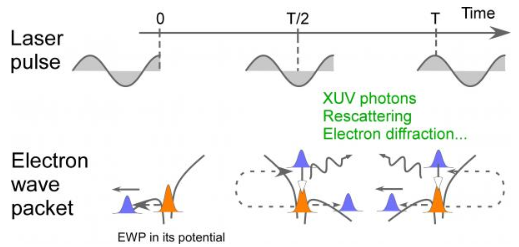
Atoms in a strong laser field: an electron wave packet is launched and driven by the field over one optical cycle. The EWP can return to its parent ion and be scattered as an outgoing electron wave or an attosecond burst of XUV light. The EWP recollision has therefore a double interest: it can be exploited either as a probe of the system with an extreme resolution, or as an ultra-short source of XUV light.
The dynamics of atomic and molecular electrons in a strong laser field is particularly rich and has been a central research topic at LIDYL for more than thirty years. This program is experimentally and theoretically continued in the Attophysics group.
Basically, the ultra-fast electron dynamics in a strong laser field can be described from both quantum and semi-classical concepts, as for instance electron wave packets and electron trajectories, respectively. The semi-classical picture has popularized the elementary dynamical process under the so-called “three-step” model [P. Corkum, Phys. Rev. Lett. 71, 1994 (1993)].
Its profound physical content is illustrated in the figure. When the atom (molecule) is submitted to a laser field – in the intensity range 1013-1016 W/cm2, that is strong enough to distort significantly the core potential -, an electron initially in a valence orbital can escape the core (step 1). This electron subsequently "rides" the laser field and may return back to its parent core within one optical cycle (of duration 2.7 fs = 2.7 10-15 s with the infra-red lasers we use), after it has gained kinetic energy in the field up to a few tens or even hundreds of electronvolts (step 2). In the recollision with the core, the electron can be quasi-elastically scattered (electron diffraction) or inelastically but coherently scattered (step 3). In the latter inelastic recollision, the electron can either further ionize the core or recombine radiatively with it, releasing its energy as an attosecond burst of extreme–UV light. The above three steps including the attosecond emission constitute the elementary sequence in High Harmonic Generation or HHG, first observed in 1987 simultaneously in Chicago and Saclay [A. Mc Pherson et al., J. Opt. Soc. Am. B 4, 595 (1987), M. Ferray et al., J. Phys. B 21, L31 (1988)]. Each optical cycle drives two recollisions so that a train of attosecond pulses in produced in HHG; their temporal characterisation was first achieved in Saclay in 2001 [P.-M. Paul et al., Science 292, 1689 (2001)].
The atomic/molecular electron dynamics in the strong field encompass basic processes, such as ionization and EWP scattering in the different channels, which are studied for themselves along by two research lines. They are detailed in the Multiple ionization & Molecular Imaging and High Harmonic Generation and Attosecond physics pages.
Now, speaking quantum mechanics, the electron is better described as an electron wave packet (EWP) that dynamically splits into two parts, respectively bound and quasi-free, in the laser field, where the quasi-free component undergoes the recollision and scattering onto the core. The free EWP has a de Broglie wavelength in the Angstrom range, which makes it a very appropriate local probe of the system which extends over a comparable scale. Since the EWP probe has attosecond temporal resolution, it can in principle image ultra-fast motion of electrons and nuclei in molecules. Two research lines, described in the Ultra-fast imaging of molecules from electron diffraction and High Harmonic Generation and Attosecond physics pages, build on this "self-probing" paradigm.
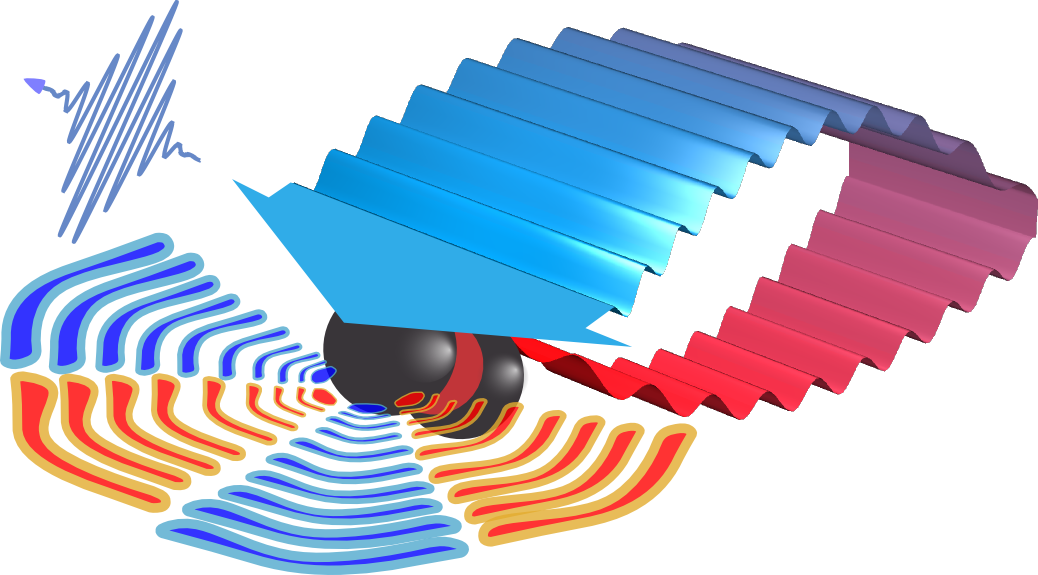
Recolliding EWP in a strong laser field. The two coherent scattering channels, EWP diffraction and EWP radiative recombination keep an imprint of the nuclear structure and the electronic orbital in the molecule.
Besides the fundamental studies of the electron dynamics in strong field, and its use as a probe of transient systems, HHG provides with a source of ultra-short coherent pulses in the XUV (from 100 nm down to a few nm). The source's brightness, which reflects the high instantaneous flux and coherence in both the "narrowband" femtosecond and "broadband" attosecond ranges and its natural synchronization with a driving laser, make it very attractive for a number of applications. Among the Examples of applications we have performed multi-color Photoionization in the gas phase, and studies of XUV/solid interaction in the solid state. The coherence properties and partial tunability of the HHG source make it attractive for Seeding a Free Electron Laser, which constitutes another research line. A promising new application concerns the Coherent diffraction imaging of nanometric objects. Most of the applications are developed in collaboration with expert groups, either in France or in Europe, USA, Canada, Japan,…
Eventually, we pursue a theoretical activity to support the several experimental programs. It focuses on microscopic aspects of the gas phase-strong field interaction, i.e., the electron dynamics in atoms and molecules, including Strong Field Approximation (SFA) models in HHG. It also deals with the macroscopic aspects of the interaction, with the development of 3D propagation codes for the laser and XUV fields.
Le LEPO effectue des recherches dans le domaine de l’interaction lumière-matière à l’échelle nanométrique, notamment dans des assemblées de nanoparticules et des systèmes moléculaires ou hybrides organisés.
Le groupe a développé un savoir-faire important d’une part dans la microscopie de photoémission d’électrons et d’autre part dans le couplage de mesures de micro-spectroscopie optique (absorption, fluorescence, diffusion Raman, conversion de fréquence) avec des microscopies à sondes locales (AFM, STM). Une sélection de ces réalisations expérimentales est présentée ci-dessous.
Malgré la résistance des bases de l’ADN isolées en solution vis-à-vis du rayonnement UV, ce dernier peut néanmoins déclencher des réactions photochimiques conduisant à des mutations cancérigènes lorsqu’il est absorbé par la double hélice. Si les produits de ces réactions sont bien caractérisés, les processus fondamentaux qui précèdent leur formation ne sont pas encore compris. Nous travaux récents montent que :
- un photon UV n’est pas absorbé individuellement par une seule base mais collectivement par un ensemble de bases (excitons)
- un transfert d’énergie entre états excitoniques a lieu à des temps inférieurs à 100 fs
- l’organisation de bases au sein des hélices peut conduire à un abaissement de leur potentiel d’ionisation
- la formation des photo-adduits (6-4) dans une simple hélice (dT)20 a lieu en 4 ms et implique un intermédiaire de réaction.
Monomères en phase condensée
En parallèle de nos études de hélices modèles nous avons mesuré, par spectroscopie de fluorescence UV femtoseconde, les durées de vie et les déclins d'anisotropie de fluorescence de tous les bases, les nucléosides et les nucléotides en solution aqueuse, avec l'exception de la guanine; celle-ci n'étant pas suffisamment soluble.
En général, les déclins de fluorescence des constituants de l'ADN sont très rapides (< 1 ps). Leur vitesse de désactivation observée ne varie pas sensiblement avec la longueur d'onde d'observation et décroît légèrement lorsqu'on passe de la base au nucléotide. Grâce à la résolution temporelle de notre dispositif, nous avons pu mettre en évidence que, contrairement à ce qui a été annoncé dans la littérature, les déclins de fluorescence ne peuvent pas être décrits correctement par des fonctions mono-exponentielles. Cela montre que les processus de relaxation à l’état excité sont complexes. Une partie importante de la fluorescence totale (jusqu'à 75 % pour dA et dAMP) décroît à des temps inférieurs à notre résolution temporelle (< 100 fs).
Introduction
Cette activité concerne l’élaboration et l’étude de structures nanocomposites à l’état solide, réalisées à partir de nano objets pré-synthétisés puis manipulés en milieu liquide (approche bottom-up). Cette approche présente l’intérêt de pouvoir étudier l’impact des modifications intervenant à l’échelle nanométrique sur les propriétés macroscopiques des nanostructures et donc de les optimiser. Elle est développée à partir de nano-objets modèles constitués de nanoparticules de platine fonctionnalisées par la 4-mercaptoaniline (particules mères) dont l’enrobage est chimiquement modifié pour former des nanoparticules présentant des caractéristiques variables et des compositions contrôlées. Les molécules greffées à la surface des nanoparticules dont le diamètre de cœur est d’environ 2 nm, rendent ces nano-objets manipulables en solution comme des molécules.
Malgré la résistance des bases de l’ADN isolées en solution vis-à-vis du rayonnement UV, ce dernier peut néanmoins déclencher des réactions photochimiques conduisant à des mutations cancérigènes lorsqu’il est absorbé par la double hélice. Si les produits de ces réactions sont bien caractérisés, les processus fondamentaux qui précèdent leur formation ne sont pas encore compris. Nous travaux récents montent que :
- un photon UV n’est pas absorbé individuellement par une seule base mais collectivement par un ensemble de bases (excitons)
- un transfert d’énergie entre états excitoniques a lieu à des temps inférieurs à 100 fs
- l’organisation de bases au sein des hélices peut conduire à un abaissement de leur potentiel d’ionisation
- la formation des photo-adduits (6-4) dans une simple hélice (dT)20 a lieu en 4 ms et implique un intermédiaire de réaction.











